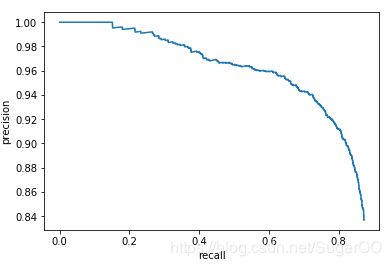FPN YOLOv3 Faster R-CNN PR 曲线 Precision-Recall 曲线 绘制
本文所使用的代码库:
FPN:https://github.com/DetectionTeamUCAS/FPN_Tensorflow
YOLOv3:https://github.com/ultralytics/yolov3
Faster R-CNN:https://github.com/jwyang/faster-rcnn.pytorch
之前研究了半天,解决之后才发现很简单。。。
方法:
其实大部分代码的作者已经实现了这部分内容,只要找到具体位置就可以了。
如果你用的不是这三个版本的代码,或者你所用的版本没有直接实现绘制 pr 曲线的代码也没关系,只要代码中可以输出模型最终的 ap 值,那么也能绘制出 pr 曲线。
因为计算 ap 值需要用到所有检测框的 precision 和 recall,而这两个变量也是绘制 pr 曲线所需的数据,所以只要你在代码中找到这两个变量的位置就可以绘制出 pr 曲线了。
precision 和 recall 这两个变量应该还是蛮好找的,一般会出现在 eval.py 或 test.py 之类的文件中。可以使用编辑器的全局查找功能,找到这两个变量。
需要注意的是,有些作者会使用这两个单词的简写,比如:prec,rec 等,或者搜索 ap ,mean ap 之类的关键词也可以。
下面就是本文用到的三个代码库中 绘制 PR(precision-recall) 曲线的具体位置:
FPN
FPN:https://github.com/DetectionTeamUCAS/FPN_Tensorflow
在 voc_val.py 文件下,找到这个函数,把注释部分取消掉就好了。
运行 eval.py 文件会调用 voc_eval.py 中的这个函数,这样就可以得到 PR(precision-recall) 曲线图。
def do_python_eval(test_imgid_list, test_annotation_path):
AP_list = []
# import matplotlib.pyplot as plt
# import matplotlib.colors as colors
# color_list = colors.cnames.keys()[::6]
for cls, index in NAME_LABEL_MAP.items():
if cls == 'back_ground':
continue
recall, precision, AP = voc_eval(detpath=os.path.join(cfgs.EVALUATE_DIR, cfgs.VERSION),
test_imgid_list=test_imgid_list,
cls_name=cls,
annopath=test_annotation_path)
AP_list += [AP]
print("cls : {}|| Recall: {} || Precison: {}|| AP: {}".format(cls, recall[-1], precision[-1], AP))
# plt.plot(recall, precision, label=cls, color=color_list[index])
# plt.legend(loc='upper right')
print(10*"__")
# plt.show()
# plt.savefig(cfgs.VERSION+'.jpg')
print("mAP is : {}".format(np.mean(AP_list)))
YOLOv3
YOLOv3:https://github.com/ultralytics/yolov3
在 util.py 文件中 找到下面的 ap_per_class 函数,取消注释部分。
运行 test.py 文件,其中有语句会调用 ap_per_class 函数,完成 PR(precision-recall) 曲线绘制。
def ap_per_class(tp, conf, pred_cls, target_cls):
""" Compute the average precision, given the recall and precision curves.
Source: https://github.com/rafaelpadilla/Object-Detection-Metrics.
# Arguments
tp: True positives (list).
conf: Objectness value from 0-1 (list).
pred_cls: Predicted object classes (list).
target_cls: True object classes (list).
# Returns
The average precision as computed in py-faster-rcnn.
"""
# Sort by objectness
i = np.argsort(-conf)
tp, conf, pred_cls = tp[i], conf[i], pred_cls[i]
# Find unique classes
unique_classes = np.unique(target_cls)
# Create Precision-Recall curve and compute AP for each class
ap, p, r = [], [], []
for c in unique_classes:
i = pred_cls == c
n_gt = (target_cls == c).sum() # Number of ground truth objects
n_p = i.sum() # Number of predicted objects
if n_p == 0 and n_gt == 0:
continue
elif n_p == 0 or n_gt == 0:
ap.append(0)
r.append(0)
p.append(0)
else:
# Accumulate FPs and TPs
fpc = (1 - tp[i]).cumsum()
tpc = (tp[i]).cumsum()
# Recall
recall = tpc / (n_gt + 1e-16) # recall curve
r.append(recall[-1])
# Precision
precision = tpc / (tpc + fpc) # precision curve
p.append(precision[-1])
# AP from recall-precision curve
ap.append(compute_ap(recall, precision))
# 这里绘制pr曲线
# Plot
# fig, ax = plt.subplots(1, 1, figsize=(4, 4))
# ax.plot(np.concatenate(([0.], recall)), np.concatenate(([0.], precision)))
# ax.set_xlabel('YOLOv3-SPP')
# ax.set_xlabel('Recall')
# ax.set_ylabel('Precision')
# ax.set_xlim(0, 1)
# fig.tight_layout()
# fig.savefig('PR_curve.png', dpi=300)
# Compute F1 score (harmonic mean of precision and recall)
p, r, ap = np.array(p), np.array(r), np.array(ap)
f1 = 2 * p * r / (p + r + 1e-16)
return p, r, ap, f1, unique_classes.astype('int32')
Faster R-CNN
Faster R-CNN:https://github.com/jwyang/faster-rcnn.pytorch
这一版的作者没有直接实现绘制 PR(precision-recall) 曲线的代码,但有代码将绘制PR(precision-recall) 曲线的数据保存下来,可以利用保存下来的数据绘制PR(precision-recall) 曲线。
保存数据的代码在 pascal_voc.py 文件夹下的 _do_python_eval 函数中,不建议在这里直接加入绘制 PR(precision-recall) 曲线 的代码,使用保存下来的数据绘制要更稳妥一些。后面会介绍绘制的方法。
我这里保存数据的路径是:
output\res101\voc_2007_test\faster_rcnn_10*.pkl
或
output\res101\voc_2007_test\faster_rcnn_10*_pr.pkl
pkl文件就是保存数据的文件,每个类别有单独的 pkl 文件,除此之外还有一个总的检测结果文件。
def _do_python_eval(self, output_dir='output'):
annopath = os.path.join(
self._devkit_path,
'VOC' + self._year,
'Annotations',
'{:s}.xml')
imagesetfile = os.path.join(
self._devkit_path,
'VOC' + self._year,
'ImageSets',
'Main',
self._image_set + '.txt')
cachedir = os.path.join(self._devkit_path, 'annotations_cache')
aps = []
# The PASCAL VOC metric changed in 2010
use_07_metric = True if int(self._year) < 2010 else False
print('VOC07 metric? ' + ('Yes' if use_07_metric else 'No'))
if not os.path.isdir(output_dir):
os.mkdir(output_dir)
for i, cls in enumerate(self._classes):
if cls == '__background__':
continue
filename = self._get_voc_results_file_template().format(cls)
rec, prec, ap = voc_eval(
filename, annopath, imagesetfile, cls, cachedir, ovthresh=0.5,
use_07_metric=use_07_metric)
aps += [ap]
print('AP for {} = {:.4f}'.format(cls, ap))
# 这里保存数据
with open(os.path.join(output_dir, cls + '_pr.pkl'), 'wb') as f:
pickle.dump({'rec': rec, 'prec': prec, 'ap': ap}, f)
print('Mean AP = {:.4f}'.format(np.mean(aps)))
print('~~~~~~~~')
print('Results:')
for ap in aps:
print('{:.3f}'.format(ap))
print('{:.3f}'.format(np.mean(aps)))
print('~~~~~~~~')
print('')
print('--------------------------------------------------------------')
print('Results computed with the **unofficial** Python eval code.')
print('Results should be very close to the official MATLAB eval code.')
print('Recompute with `./tools/reval.py --matlab ...` for your paper.')
print('-- Thanks, The Management')
print('--------------------------------------------------------------')
绘制 PR 曲线
import matplotlib
import pickle
import matplotlib.pyplot as plt
def draw_single_pr_curve(pkl_file_path):
# 若在图中添加中文,可加入下面两行
#plt.rcParams['font.sans-serif']=['SimHei'] #用来正常显示中文标签
#plt.rcParams['axes.unicode_minus']=False #用来正常显示负号
#有中文出现的情况,需要u'内容'
pkl_file = open(pkl_file_path,'rb')
pr_curve_data = pickle.load(pkl_file)
recall = pr_curve_data['rec']
precision = pr_curve_data['prec']
plt.xlabel('recall')
plt.ylabel('precision')
plt.plot(recall,precision)
plt.show()
your_pkl_file_path = '你的pkl文件路径'
draw_single_pr_curve(your_pkl_file_path )
